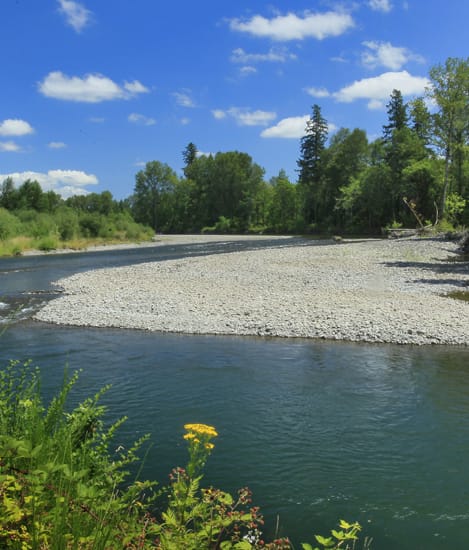Oregon’s Willamette River and its expansive floodplain were once a lacework of side channels, wetlands and wet prairies, with extensive riparian forests that provided rich habitat for fish and wildlife. Today, after more than a century of development, Willamette Valley wetlands and wet prairies are some of the most endangered habitat types in Oregon, and the valley’s deciduous forests are found only in pockets. The best of what remains of these habitats occur primarily along Willamette tributaries like the North Santiam River.
The North Santiam flows 92 miles from the Cascade Mountains to the main-stem Santiam, a tributary to the Willamette River. It once produced more salmon and steelhead than any Willamette tributary, fully two-thirds of the Willamette’s winter steelhead and a third of its spring Chinook. Today, both of these runs are listed as threatened under the Endangered Species Act. With the goal of improving habitat for these fish, and to conserve vital remaining wildlife habitat in the Willamette Valley, Western Rivers Conservancy is working to protect land along outstanding reaches of the North Santiam.
In early 2015, we completed Chahalpam, a project in partnership with Oregon’s Confederated Tribes of Grand Ronde, that conserved 429 acres along the North Santiam. The effort conserved over 2.5 miles of main-stem and side-channel frontage, including extensive spawning and rearing habitat for salmon and steelhead. More than 147 acres of floodplain forests, including mature stands of black cottonwood, big-leaf maple and red alder, as well as 30 acres of rare wetlands were permanently protected. The project conserved prime habitat for imperiled animals like the western pond turtle, red-legged frog and Oregon chub.
WRC conveyed these lands to the Tribe, which renamed them “Chahalpam,” meaning “place of the Santiam Kalapuya people.” The Tribe shares WRC’s conservation vision for the area and will steward the lands for the benefit of the region’s imperiled fish, wildlife and fauna.
WRC and the Grand Ronde Tribe expanded on this success the following year when WRC purchased the 411-acre Erpelding farm, just upstream, and conveyed it to the Tribe. Our efforts conserved nearly three additional miles of mainstem and tributary frontage, as well as 12.8 acres of seasonally flooded wetlands. We protected more than 200 acres of closed-canopy riparian forest and 82 acres of open-canopy forest. These increasingly rare forests include a diverse array of native tree species like Douglas and grand fir, western hemlock, Pacific yew, western red cedar, Oregon white oak and red alder.
Acquisition funding for both projects was provided by the Bonneville Power Administration through the Willamette Wildlife Mitigation Program, a partnership with Oregon Department of Fish and Wildlife. With these projects now complete, WRC and its partners protected over five miles of the North Santiam River and some of the finest remaining forest and wetlands in the Willamette Valley.
Critical support for our work on the North Santiam River was provided by the Bullitt Foundation, Clark-Skamania Flyfishers, Meyer Memorial Trust, Portland General Electric, Saling Foundation, Spirit Mountain Community Fund and Westfly, Inc.











